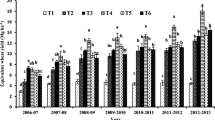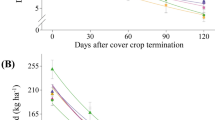Abstract
Cover plants are intended to cover the soil, protecting it from erosion, nutrient leaching, and providing nutrients through recycling or biological fixation. The objectives of this study were to evaluate the dry biomass productivity and total accumulation of nutrients in the cover crops shoots and in the upland rice grown in succession; and evaluate the effect of the isolated and combined use of cover crops and urea on upland rice crop, grown under no-tillage system. The field experiment was conducted at Selviria-MS, Brazil, in an Oxisol (Rhodic Ilaplustox), cerrado (savannah) phase. The experimental design was randomized blocks, in a 5x3 factorial scheme. The treatments were four cover crops species: sunn hemp (Crotalaria juncea L.), pigeon pea (Cajanus cajan L.), green velvet bean (Mucuna prurens), millet (Pennisetum glaucum L.), and spontaneous vegetation (fallow in off-season) combined with 20 kg N ha-1 applied at sowing, 20 kg N ha-1 applied at sowing + 60 kg N ha-1 at plus topdressing, and without mineral N fertilizer application. The millet recycled large amounts of K, Mg, S, and micronutrients, but negatively influenced the rice grain yield grown in succession. There was no response to topdressed mineral N fertilizer when the crop was grown in rotation to legume cover crops. Upland rice under no-tillage showed a positive response to the N fertilization at seeding and when it is grown in rotation with the use of millet or fallow in the off-season. Upland rice also showed a response to N fertilization applied at topdressing.
Similar content being viewed by others
Change history
16 April 2020
Due to an unfortunate oversight the author���s name and affiliation have been given erroneously. It should be read:
References
Acosta JAA, Amado TJC, Neergaard A, Vinther M, Silva LS, Nicoloso RS. 2011. Effect of 15N-labeled hairy vetch and nitrogen fertilization on maize nutrition and yield under no-tillage. Rev Bras Cienc Solo. 35: 1337–45
Alcântara FA, Ferreira Neto AE, Paula MB, Mesquita HA, Muniz JÁ. 2000. Adubação verde na recuperação da fertilidade de um Latossolo vermelho-escuro degradado. Pesqui. Agropecu. Bras. 35: 277–288
Alvares CA, Stape JL, Sentelhas PC, Gonçalves JLM, Sparovek G. 2013. Köppen’s climate classification map for Brazil. Meteorol. Z. 22: 711–728
Alvarez RCF, Crusciol CAC, Rodrigues, JD, Alvarez ACC. 2005. Marcha de absorção de nitrogênio de cultivares de arroz de terras altas com diferentes tipos de plantas. Científica 34: 162–69
Alvarez RCF, Crusciol CAC, Trivelin PCO, Rodrigues JD, Alvarez ACC. 2007. Influência do etil-trinexapac no acúmulo, na distribuição de nitrogênio (15N) e na massa de grãos de arroz de terras altas. Rev. Bras. Cienc. Solo. 31: 1487–96
Amabile RF, Fancelli AL, Carvalho AM. 1999. Absorção de N, Pe K por espécies de adubos verdes cultivadas em diferentes épocas e densidades num Latossolo vermelho-escuro argiloso sob cerrados. Rev. Bras. Cienc. Solo. 23: 837–845
Araújo ES, Medeiros AFA, Dias FC, Urquiaga S, Boddey RM, Alves BJR. 2004. Quantificação do N do solo derivado das raízes da soja utilizando o isótopo 15N. Rev. Unive. Rural. 1: 1–7
Arf O, Bastos JCHAG, Silva MG, Sá ME, Rodrigues RAF, Buzetti S. 2005. Manejo do solo e época de aplicação de nitrogênio na produção de arroz de terras altas. Acta Sci. Biol. Sci. 27: 215–23
Azam F, Mulvaney RL, Simmons FW. 1995. Effects of ammonium and nitrate on mineralization of nitrogen from legumes residues. Biol. Fert. Soils 20: 49–52
Boer CA, Assis RL, Silva GP, Braz AJBP, Barroso ALL, Cargnelutti Filho A, Pires FR. 2008. Biomassa, decomposição e cobertura do solo ocasionada por resíduos culturais de três espécies vegetais na região centro-oeste do Brasil. Rev. Bras. Cienc. Solo. 32: 843–51
Bordin L, Farinelli R, Penariol FG, Fornasieri Filho D. 2003. Sucessão de cultivo de feijão-arroz com doses de adubação nitrogenada após adubação verde, em semeadura direta. Bragantia 62: 417–428
Carvalho AM, Bustamante MMC, Geraldo Junior J, Vivaldi LJ. 2008. Decomposição de resíduos vegetais em Latossolo sob cultivo de milho e plantas de cobertura. Rev. Bras. Ciênc. Solo. 32: 2831–2838
Carvalho AM, Souza LLP, Guimarães Júnior R, Alves PCAC, Vivaldi JL. 2011. Cover plants with potential use for crop livestock integrated systems in the Cerrado region. Pesqui. Agropecu. Bras. 46: 1200–5
Cazetta DA, Arf O, Buzetti S, Sà, ME, Rodrigues RAF. 2008. Desempenho do arroz de terras altas com a aplicação de doses de nitrogênio e em sucessão às culturas de cobertura do solo em sistema de plantio direto. Bragantia 67: 471–79
Companhia Nacional de Abastecimento - CONAB. 2019. Acompanhamento da safra brasileira de grãos. Décimo segundo levantamento, Brasília, DF. http://www.conab.gov.br (Accessed Aug 3 2019)
De Bruijn FJ. 2015. Biological nitrogen fixation. In Principles of Plant-Microbe Interactions. Springer, 215–224
Fageria NK, Baligar VC, Jones CA. 2011. Growth and mineral nutrition of field crops. 3th ed. Boca Raton, CRC Press
Fageria NK, Baligar VC, Li YC. 2008. The role of nutrient efficient plants in improving crop yields in the Twenty-First Century. J. Plant Nutr. 31: 1121–1157
Fageria NK, Morais OP, Santos AB. 2010. Nitrogen use efficiency in upland rice genotypes. J. Plant Nutr. 33: 1696–711
Food and Agriculture Organization - FAO. 2017. The state of food security and nutrition in the World 2017. http://www.fao.org/state-of-food-security-nutrition/en/ (Accessed Apr 2 2018).
Guimarães CM, Stone LF. 2003. Adubação nitrogenada do arroz de terras altas no sistema de plantio direto. Rev. Bras. Eng. Agr. Amb. 7: 210–14
Guimarães GL, Buzetti S, da Silva EC, Arf O, de Sá ME, Bastos AVS. 2018. Agronomic performance of cover crops and upland rice cultivars grown in sucession with different nitrogen rates in no-tillage system. Cult. Agron. 27: 173–189
Hernandes A, Buzetti, S, Andreotti, M, Arf, O, Sá MED. 2010. Doses, fontes e épocas de aplicação de nitrogênio em cultivares de arroz. Ciênc. Agrotec. 34: 307–312
International Rice Research Institute - IRRI. 2002. Standard evaluation system for rice. Los Baños, Philippines. p. 65
Machado JR. 1994. Desenvolvimento da planta e produtividade de grãos de populações de arroz (Oryza sativa L.) irrigado por inundação em função de épocas de cultivo. Ph. D. thesis Botucatu: Faculdade de Ciências Agronômicas, Universidade Estadual Paulista
Malavolta E, Vitti GC, Oliveira SA. 1997. Avaliação do estado nutricional das plantas: princípios e aplicações. 2th ed. Piracicaba: Potafos
Marschner H. 1995. Mineral nutrition of higher plants. 2th ed. San Diego: Academic Press, 889 p
Muraoka T, Ambrosano EJ, Zapata F, Bortoletto N, Martins ALM, Trivelin PCO, Boaretto AE, Scivittaro WB. 2002. Eficiencia de abonos verdes (crotalaria y mucuna) y urea, aplicadas solos o juntamente, como fuentes de N para el cultivo de arroz. Terra 20: 17–23
Nascente AS, Crusciol CAC, Cobucci T. 2013a. The no-tillage system and cover crops–Alternatives to increase upland rice yield. Eur. J. Agron. 45: 124–31
Nascente AS, Crusciol CAC, Cobucci T, Velini ED. 2013b. Cover crop termination timing on rice crop production in a no-till system. Crop Sci. 53: 2659–69
Pegoraro RF, Silva IR, Novais RF, Mendonça ES, Alvarez VVH, Nunes FN, Gebrim FO. 2006. Fluxo difusivo de micronutrientes catiônicos afetado pelo tipo, dose e época de incorporação de adubos verdes ao solo. Rev. Bras. Ciênc. Solo. 30: 997–1006
Perin A, Santos RHS, Urquiaga S, Guerra JGM, Cecon PR. 2004. Produção de fitomassa, acúmulo de nutrientes e fixação biológica de nitrogênio por adubos verdes em cultivo isolado e consorciado. Pesqui. Agropecu. Bras. 39: 35–40
Raij B van, Andrade JC, Cantarella H, Quaggio JA. 2001. Análise química para avaliação da fertilidade de solos tropicais. Campinas: Instituto Agronômico
Raij B van, Cantarella H, Quaggio JA, Furlani AMC. 1996. Recomendações de adubação e calagem para o Estado de São Paulo. 2th ed. Campinas: Instituto Agronômico de Campinas. (Boletim Técnico, 100)
Raun WR, Solie S, Johnson, GV, Stone ML, Mullen RW, Freeman KW, Thomson WE, Lukina EV. 2002. Improving nitrogen use efficiency in cereal grain production with optical sensing and variable rate application. Agron. J. 94: 815–820
Ryan J, Ibrikci H, Singh M, Matar A, Masri S, Rashid A, Pala M. 2007. Response to residual and currently applied phosphorus in dryland cereal/legume rotations in three Syrian Mediterranean agroecosystems. Eur. J. Agron. 28: 126–137
Santos HG, Jacomine PKT, Anjo LHC, Oliveira VA, Lumbreras JF, Coelho MR, Almeida JA, Cunha TJF, Oliveira JB. 2018. Sistema brasileiro de classificação de solos. 3th ed. Brasília: Embrapa, 353 p
Sas Institute Incorporation. 2001. The SAS-System for Windows release 8.02 (TS2M0) (software). SAS Institute Inc. Cary, NC, USA
Scivittaro WB, Muraoka T, Boaretto AE, Trivelin PCO. 2004. Fate of nitrogen (15N) from velvet bean in the soil-plant system. Sci. Agr. 61: 210–5
Silva EC, Muraoka T, Buzetti S, Veloso MEC, Trivelin PCO. 2006a. Aproveitamento do nitrogênio (15N) da crotalária e do milheto pelo milho sob plantio direto em Latossolo Vermelho de Cerrado. Ciênc. Rural. 36: 739–46
Silva EC, Muraoka T, Guimarães GL, Buzetti S. 2006b. Acúmulo de nutrientes em plantas de cobertura e no milho cultivado em sucessão sob diferentes doses de nitrogênio em plantio direto. Rev. Bras. Mil. Sor. 5: 203–217
Silva EC, Muraoka T, Buzetti S, Espinal FSC, Trivelin PCO. 2008. Utilização do nitrogênio da palha de milho e de adubos verdes pela cultura do milho. Rev. Bras. Ciênc. Solo. 32: 2853–2861
Silva EC, Muraoka T, Franzini VI, Sakadevan K, Buzetti S, Arf O, Bendassolli JA, Soares FAL. 2016. Use of nitrogen from fertilizer and cover crops by upland rice in an Oxisol under no-tillage in the Cerrado. Pesqui. Agropecu. Bras. 51: 28–737
Singh A, Kumarand R, Kang JS. 2014. Tillage system, crop residues and nitrogen to improve the productivity of direct seeded rice and transplanted rice. Curr. Agric. Res. J. 2: 14–29
Soil Survey Staff. 2010. Keys to Soil Taxonomy. 11th ed. Washington: United States Department of Agriculture, Natural Resources Conservation Service, 338 p
Souza LCD, Sá ME, Martins HSD, Abrantes FL, Silva MP, Arruda N. 2010. Produtividade e qualidade de sementes de arroz em resposta a doses de calcário e nitrogênio. Rev. Trop. Cienc. Agr. Bio. 4: 27–35
Teixeira CM, Carvalho GJ, Andrade MJB, Silva CA, Pereira JM. 2009. Decomposição e liberação de nutrientes das palhadas de milheto e milheto + crotalária no plantio direto do feijoeiro. Acta Sci. Agr. 31: 647–53
Torres JLR, Pereira MG, Fabian AJ. 2008. Produção de fitomassa por plantas de cobertura e mineralização de seus resíduos em plantio direto. Pesqui. Agropecu. Bras. 43: 421–28
Acknowledgements
To FAPESP for the research scholarship granted to the first author and for the financial support of this research; to IAEA for the financial support and to CNPq for the research fellowship to the other authors.
Author information
Authors and Affiliations
Corresponding author
Additional information
Conflict of interest
The authors declare that there is no conflict of interest.
Rights and permissions
About this article
Cite this article
da Silva, E.C., Muraoka, T., Bastos, A.V.S. et al. Biomass and Nutrient Accumulation by Cover Crops and Upland Rice Grown in Succession Under No-Tillage System as Affected by Nitrogen Fertilizer Rate. J. Crop Sci. Biotechnol. 23, 117–126 (2020). https://doi.org/10.1007/s12892-019-0288-0
Received:
Revised:
Accepted:
Published:
Issue Date:
DOI: https://doi.org/10.1007/s12892-019-0288-0




